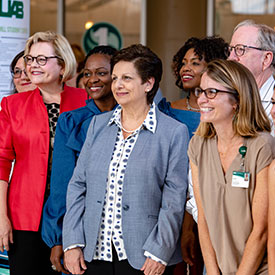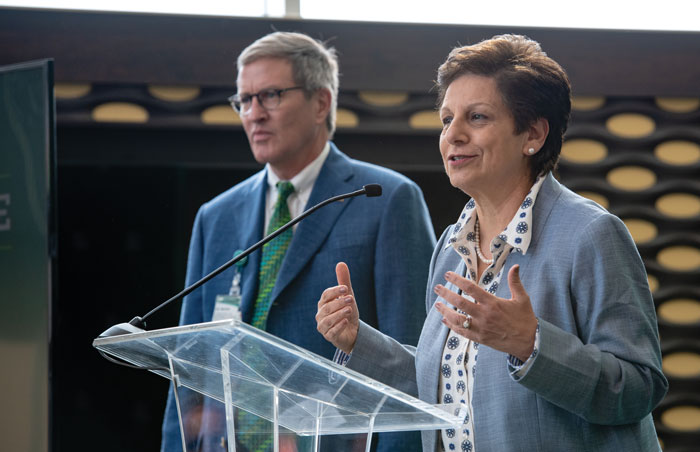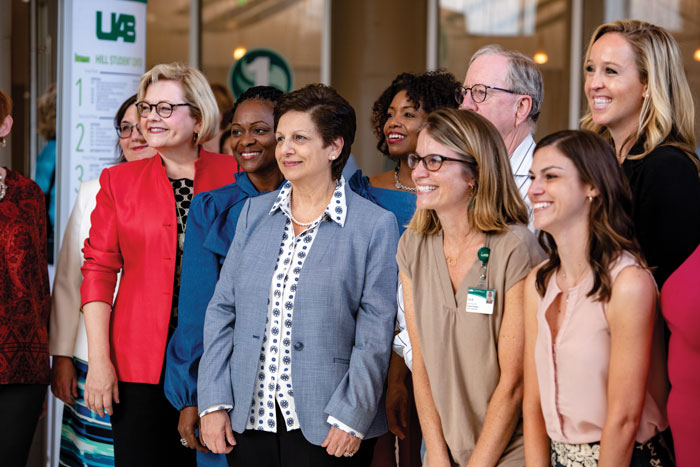 The diseases are familiar. So are the state’s rankings.
The diseases are familiar. So are the state’s rankings.
Alabama has the highest prevalence of stroke, the third-highest rate of diabetes and kidney disease, the fourth-highest incidence of heart disease, and the fifth-highest adult obesity rate. Turning these statistics around is a challenge that Mona Fouad, M.D., MPH, director of the UAB Minority Health & Health Disparities Research Center, director of the Division of Preventive Medicine, and senior associate dean for diversity and inclusion in the School of Medicine, and her team have accepted.
In May, UAB named Fouad’s “Healthy Alabama 2030: Live HealthSmart” the winning proposal of the university’s first Grand Challenge, a key component of UAB’s strategic plan called Forging the Future. Grand Challenges are ambitious goals that have the potential to capture the public’s imagination. They are designed to increase support for policies and investments that foster innovation. They also serve as compelling “North Stars” for cross-sector and multidisciplinary collaboration.
Fouad’s ambitious project aims to elevate Alabama out of the bottom 10 in national health rankings by 2030. Her plan will utilize a systematic and comprehensive approach to make significant improvements in key health metrics over the next 10 years.
“Our health is everything,” says Fouad, a 2018 inductee into the National Academy of Medicine. “It is the core of good quality of life, productive employees, successful students and happiness in general. We must do better by our citizens. We must educate, reach more people where they are, and not put Band-Aids on problems. Rather, we must work collectively to change our paradigm and improve our state’s health so we as Alabamians can reach our full potential.”
The university awarded Fouad’s team a three-year, $2.7 million award to fund the initial effort. Their comprehensive, team-based approach to fixing these complex problems includes 90 partners from government, business, education, and more in both leadership and advisory roles.
“It is very fitting—and by design—that we embark on our Grand Challenge in UAB’s 50th anniversary year, and it is equally fitting that a nationally recognized pioneer in health disparities research like Dr. Fouad will work with a large team of collaborators to solve our state’s most complex health problems,” says UAB President Ray Watts, M.D. “She has assembled an impressive coalition of collaborators and supporters from our university and across the state. UAB’s phenomenal growth and success over five decades have been fueled by intense collaboration and innovation. Those very strengths—in their fullest measure—will enable us to achieve our Grand Challenge.”
“Like America’s goal to put a man on the moon, Grand Challenges have a history of catalyzing innovation for society’s benefit,” says UAB Vice President for Research Christopher Brown, Ph.D. “When we announced this endeavor, we said it would unite university activities—teaching, research, scholarship, commercialization, patient care, and service—along with strengthen partnering organizations’ capabilities to solve large-scale problems affecting Alabama. Our rankings indicate the health of our state is a large-scale problem. The team Dr. Fouad has assembled will find the solutions needed to positively impact those numbers, which will help our citizens achieve better health and propel our state forward.”
 Mona Fouad speaks at an April 30 event announcing the inaugural Grand Challenge winning project,
Mona Fouad speaks at an April 30 event announcing the inaugural Grand Challenge winning project,
Healthy Alabama 2030.
Stepping Up
The long-term goal is to get Alabama’s health rankings into the 30s in key metrics—obesity, diabetes, high blood pressure, and high cholesterol—which Fouad says will take about 10 years. For example, reducing the state’s obesity rate from 36.3 percent to 33 percent would move Alabama from 46th to 37th nationally.
The mid-term objective will be “to improve health behavior—getting people to eat more fruits and vegetables, exercise, stop smoking, lower blood pressure and cholesterol, and screen for cancer and chronic diseases,” Fouad explains.
The strategies behind it all, she says, fall into three categories: changing the rules through policy initiatives, changing structures such as schools and workplaces through new programs, and changing the environment in which we live by moving good health to the forefront. These three often go hand in hand. Updates to land-use zoning codes, innovative educational programs to encourage exercise, and physical improvements such as new sidewalks, can combine to make neighborhoods more pedestrian-friendly and increase physical activity rates, for instance.
“We were very pleased with the planning phase built into the UAB Grand Challenge process,” Fouad says. “That gave us time to engage with the community. We held a series of partner and town hall meetings where we met with citizens, organizations, and more than 100 community leaders in five counties. We developed our strategies based on the needs and challenges they shared with us.”
Theresa Wallace, Ph.D., a program director in the Division of Preventive Medicine, is the program director for the Healthy Alabama 2030 project. She says three common themes emerged from the town hall meetings.
“People talked about modifying the built environment so physical activity is easier or more accessible, changing the food environment to promote good nutrition, and transforming the health care setting to facilitate prevention and wellness,” Wallace says. “People want to know, ‘How can I transform my community into one where healthy living is the easy, default choice? How can I proactively take my health into my own hands?’ If we do it effectively, which we’ve done in the past, we can truly make a difference.”
 Mona Fouad (center front) and the winning Grand Challenge team.
Mona Fouad (center front) and the winning Grand Challenge team.
Prescription for Change
Healthy Alabama 2030 will launch with demonstration zones at UAB and in three Birmingham communities, Fouad says. These communities—Woodlawn/Kingston, Bush Hills/Ensley, and Eastlake—are central to the city’s strategic plan, she adds. Healthy Alabama 2030 complements strategic plans and initiatives at UAB and other partner organizations, including the state Department of Public Health.
To make major changes, the team will leverage programs that already have proved successful on a smaller scale, Fouad says. For example, UAB Wellness initiatives led to a 13% increase in colorectal cancer screenings and gave thousands of employees eye-opening insights into their health through the WELLSCREENS campaign. “This project collectively pulls together so many good things that are already happening,” says Employee Wellness Director Anna Threadcraft, who is co-principal investigator for systems in the Healthy Alabama 2030 team. “We can share what works and what doesn’t so we all get better.”
Parks Rx, a program from the MHRC’s Birmingham REACH for Better Health initiative, has been connecting residents to 139 Birmingham-area parks since 2016. Physicians with the Jefferson County Department of Health write “exercise prescriptions” for their patients. When patients enter their ZIP codes on a smartphone, computer, or health department kiosk, they get directions to the closest parks and details about trail length, hours, and pet policies. Another REACH partner distributes produce to small corner convenience stores in Kingston and North Avondale. “What if we have an app that connects to the trucks and food banks so residents can see when the trucks are coming and what they have in stock?” Fouad says. “Everyone has a smartphone now. We are trying to develop innovations that are sustainable.”
Students will also play a major role in making a difference through new service learning opportunities, says Lisa McCormick, DrPH, associate dean for public health practice in the School of Public Health and co-principal investigator for measures and evaluations for Healthy Alabama 2030. That could include everything from mapping abandoned structures to mentoring in local schools. “We teach students these skills in the classroom; this is the application,” McCormick says. “This will show students how they can work in Alabama communities to solve Alabama problems.”
Solving problems close to home is a great motivator for faculty as well, Fouad says. “Everyone is excited,” she says. “We know we can improve, and we know the behaviors to focus on. The Grand Challenge has given us a great opportunity to scale up the successful projects we’ve piloted and sustain them for the long term. We’re all joining together to have a lasting impact on our campus, the city, and the entire state.”
By Tyler Greer
Grand Challenge Finalists
The UAB Grand Challenge inspired 77 initial entries from teams across campus and the community. Following workshops, teams formed to further develop and consolidate their concepts, eventually producing six fully formed and impressive proposals that are listed below.
Advanced Materials and Computation to Solve 21st-Century Alabama Grand Challenges
Would position UAB, Birmingham, and Alabama at the epicenter of the race to develop the advanced materials that will power the 21st century
Birmingham 2030: Roadmap to a Model City
Shapes Birmingham as a large-scale national and global testbed for new approaches in technology, policy, and sustainability to build equitable model cities
Opioid Overdose Prevention and Treatment
Promotes clinical intervention, education, and research to prevent opioid overdoses
Alabama HOPE Project
Brings longer, better lives to rural and urban Alabama through education, health, and economic opportunity, starting in Birmingham and Marengo County
REACH (Reengineering Equal Access to Comprehensive Health Care)
Lack of access to care is the biggest contributor to Alabama’s health woes, and technology offers a solution, according to the REACH project, which seeks to transform life in Alabama through telehealth
Learn more about all the finalists at www.uab.edu/plan/grand-challenge.